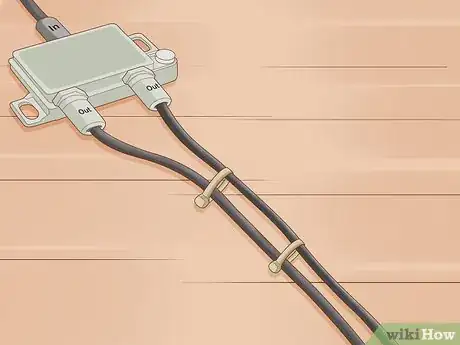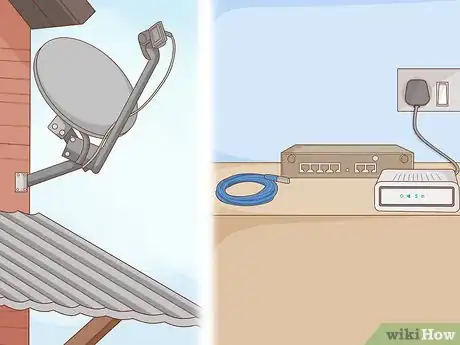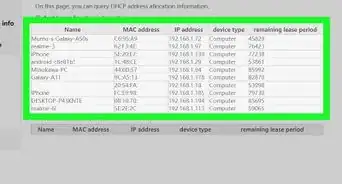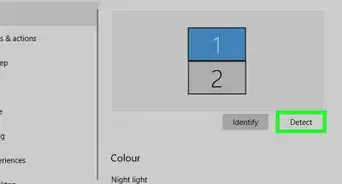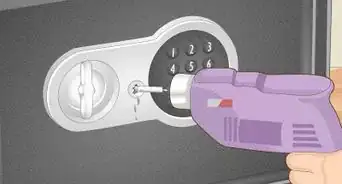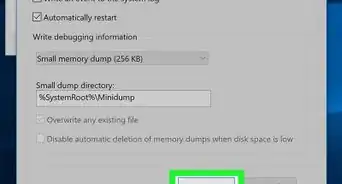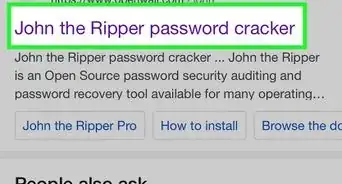This article was co-authored by Luigi Oppido and by wikiHow staff writer, Jack Lloyd. Luigi Oppido is the Owner and Operator of Pleasure Point Computers in Santa Cruz, California. Luigi has over 25 years of experience in general computer repair, data recovery, virus removal, and upgrades. He is also the host of the Computer Man Show! broadcasted on KSQD covering central California for over two years.
This article has been viewed 235,506 times.
This wikiHow teaches you how to install and use Satellite internet in your home or mobile location. Satellite Internet is often the only option for people living in remote, rural areas in which cable companies don't offer service. Keep in mind that Satellite Internet can be erratic, so large-bandwidth actions such as streaming HD video or playing online video games may be impossible during certain times in the day.
Things You Should Know
- If multiple satellite providers are available in your area, compare their download and upload speeds and check out customer reviews.
- If you already have satellite television service, check with your provider to see if they offer an internet plan.
- Most satellite internet providers will come to your location and install the dish for you. If not, they'll provide you with an easy installation guide.
Steps
Signing up
-
1Consider your options. Depending on your geographic location, you may have several different choices for Satellite Internet service providers. Each will most likely come with their fair share of pros and cons, so find as many options as possible.[1]
- The main two providers in North America are Viasat and HughesNet.
-
2Compare download and upload speeds. Ultimately, the quality of your Satellite Internet will depend on your service's speed. Compare the available services' upload and download speeds to each other; whichever service is faster will usually be the better choice.Advertisement
-
3Check reviews for your selected service. Look up online customer reports regarding the service's performance; if you see generally favorable reviews, the service is probably fine.
- Keep in mind that some customers will undoubtedly leave negative reviews due to inconsistent service, outages during certain conditions (e.g., weather), or the high price point when compared to cable Internet. All three of these problems are inherent Satellite Internet issues, so take such reviews with a grain of salt.
-
4Sign up for a Satellite Internet subscription. Once you've determined the service you want to use, sign up for it to select a plan and enter your payment information.
- You can usually do this online, though you can usually also call the service provider instead.
-
5Buy a modem if one isn't included. If your Satellite Internet service doesn't include a modem, purchase one that supports satellite Internet.
- Your Satellite Internet subscription should include a dish.
Installing the Satellite Dish
-
1See if installation services are available. Many Satellite Internet services will install your dish for you; if you're in an area that supports this, allow a professional to install your dish instead of doing it yourself.
- If you have to install the dish in variable locations (e.g., a boat or an RV), you may have to take care of the installation yourself.
-
2Adjust the dish to point toward the equator. Since the satellites that transmit your Internet are positioned directly over the Earth's equator, you should not have any obstructions that prevent you from having an optimal connection.
- Have your satellite dish installed in an open area away from trees and similar obstructions. For example, if you live in North America, place the dish on the southern-most tip of your roof or south of any tall trees, so it can point toward the equator.
-
3Anchor the satellite dish to your roof. Using the hardware that comes with your satellite dish, screw the base of the dish into a flat part of your roof. The dish should have a clear, unobstructed view of the sky.
- Make sure the connections are tight, and don't install your dish in a loose or unstable section of roof.
- If you have a balcony or similarly proportioned part of your house that has a clear view of the sky over the equator, you can use it to mount your dish instead.
-
4Attach coaxial cables to your dish. Many dishes use two coaxial cables to connect to your Internet hardware, but your dish may only use one.
- When attaching the coaxial cables to the dish, you should see an "IN" port and an "OUT" port on the dish. Consider marking the other ends of your coaxial cables to correspond with these ports—you'll need to know which is which when connecting them to your modem.
-
5Secure the coaxial cables. You'll usually use staples or hose ties to anchor the coaxial cables to your roof. Be sure to keep the cables away from sharp objects, and secure them as tightly as possible; you don't want the cables to come loose during a storm.
- Depending on your home, you may need to drill a hole through which you can thread the coaxial cables before you can use the cables in your home.
Getting Online
-
1Make sure you have the necessary equipment. Before attempting to connect to Satellite Internet, you'll need to have the following items available:
- Installed satellite dish
- Satellite Internet-capable modem
- Ethernet cable
- Power source
-
2Position your computer. Your computer should be close to both your modem and your dish's coaxial cable(s).
- Most dish coaxial cables are under 125 feet in length, so you might have to position your modem accordingly.
-
3Plug the modem into a power source. Using the modem's power cable, attach it to an electrical outlet near both your computer and the dish's coaxial cable.
-
4Attach the modem to the satellite dish. Depending on your dish, you will have either one coaxial cable or two coaxial cables to attach to the modem:[2]
- One cable — Plug the cable into the modem's coaxial port.
- Two cables — Plug the "IN" cable into the "SAT IN" coaxial port, then plug the "OUT" cable into the "SAT OUT" port.
-
5Connect your computer to the modem. Plug one end of the Ethernet cable into the back of the modem, then plug the other end of the cable into your computer's Ethernet slot.
- If you're using a Mac which doesn't have an Ethernet slot, you can buy an Ethernet to Thunderbolt adapter for this step.
-
6Wait for your computer to establish an Internet connection. As long as your dish is currently receiving a signal from its pertinent satellite, you should be able to begin browsing within a minute of connecting your computer to the modem.
-
7Use a wireless router. If you're connecting more than one item to the Internet, you'll need to plug your modem into a wireless router via an Ethernet cable and then use each item's Wi-Fi menu to connect to the router.
- Using a wireless router isn't recommended unless absolutely necessary; since Satellite Internet is already patchy under normal circumstances, using a wireless router may further dilute your signal.
Expert Q&A
-
QuestionCan you work from home with satellite Internet?
 Luigi OppidoLuigi Oppido is the Owner and Operator of Pleasure Point Computers in Santa Cruz, California. Luigi has over 25 years of experience in general computer repair, data recovery, virus removal, and upgrades. He is also the host of the Computer Man Show! broadcasted on KSQD covering central California for over two years.
Luigi OppidoLuigi Oppido is the Owner and Operator of Pleasure Point Computers in Santa Cruz, California. Luigi has over 25 years of experience in general computer repair, data recovery, virus removal, and upgrades. He is also the host of the Computer Man Show! broadcasted on KSQD covering central California for over two years.
Computer & Tech Specialist Possibly, but keep in mind that satellite internet is usually slower than other types of internet, so you probably won't get really high speeds.
Possibly, but keep in mind that satellite internet is usually slower than other types of internet, so you probably won't get really high speeds. -
QuestionHow can I set up satellite Internet on my mobile phone?
 Community AnswerYou should be able to see your satellite internet as a Wifi location. Click on the location that has the name of your network, then enter your password. You should be connected. Be sure you have a strong internet password that is not easily guessed. Hesitate using your phone for money transactions; you are opening yourself up to credit and identity theft each time. Don't use public hotspots for the same reason.
Community AnswerYou should be able to see your satellite internet as a Wifi location. Click on the location that has the name of your network, then enter your password. You should be connected. Be sure you have a strong internet password that is not easily guessed. Hesitate using your phone for money transactions; you are opening yourself up to credit and identity theft each time. Don't use public hotspots for the same reason. -
QuestionIs a meter application provided in order to keep track of what is downloaded or uploaded so the limits are not exceeded?
 Community AnswerMost ISPs provide a usage meter which is accessible via your account dashboard. It records your downloads and uploads as separate totals for each 24-hour period, with access to their websites as unmetered usage. I suggest you contact your ISP Sales & Support team for more details.
Community AnswerMost ISPs provide a usage meter which is accessible via your account dashboard. It records your downloads and uploads as separate totals for each 24-hour period, with access to their websites as unmetered usage. I suggest you contact your ISP Sales & Support team for more details.
Warnings
- If you are interested in installing and setting up the satellite dish and other equipment by yourself, verify with your provider that you are legally capable of doing so. In some areas, the government will prohibit unauthorized individuals from installing satellite-related equipment.⧼thumbs_response⧽
- Since satellite Internet relies on communication from the skies, your Internet may not function fully in inclement weather such as rain or snow storms.⧼thumbs_response⧽
References
About This Article
1. Sign up for service in your area.
2. Install the satellite dish.
3. Connect the modem to the dish.
4. Turn the modem on.
5. Connect the computer to the modem.









